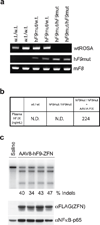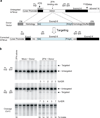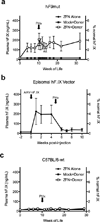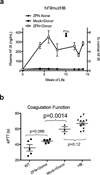In vivo genome editing restores haemostasis in a mouse model of haemophilia
- PMID: 21706032
- PMCID: PMC3152293
- DOI: 10.1038/nature10177
In vivo genome editing restores haemostasis in a mouse model of haemophilia
Abstract
Editing of the human genome to correct disease-causing mutations is a promising approach for the treatment of genetic disorders. Genome editing improves on simple gene-replacement strategies by effecting in situ correction of a mutant gene, thus restoring normal gene function under the control of endogenous regulatory elements and reducing risks associated with random insertion into the genome. Gene-specific targeting has historically been limited to mouse embryonic stem cells. The development of zinc finger nucleases (ZFNs) has permitted efficient genome editing in transformed and primary cells that were previously thought to be intractable to such genetic manipulation. In vitro, ZFNs have been shown to promote efficient genome editing via homology-directed repair by inducing a site-specific double-strand break (DSB) at a target locus, but it is unclear whether ZFNs can induce DSBs and stimulate genome editing at a clinically meaningful level in vivo. Here we show that ZFNs are able to induce DSBs efficiently when delivered directly to mouse liver and that, when co-delivered with an appropriately designed gene-targeting vector, they can stimulate gene replacement through both homology-directed and homology-independent targeted gene insertion at the ZFN-specified locus. The level of gene targeting achieved was sufficient to correct the prolonged clotting times in a mouse model of haemophilia B, and remained persistent after induced liver regeneration. Thus, ZFN-driven gene correction can be achieved in vivo, raising the possibility of genome editing as a viable strategy for the treatment of genetic disease.
©2011 Macmillan Publishers Limited. All rights reserved
Figures





Similar articles
-
Robust ZFN-mediated genome editing in adult hemophilic mice.Blood. 2013 Nov 7;122(19):3283-7. doi: 10.1182/blood-2013-04-497354. Epub 2013 Oct 1. Blood. 2013. PMID: 24085764 Free PMC article.
-
Genome editing with CompoZr custom zinc finger nucleases (ZFNs).J Vis Exp. 2012 Jun 14;(64):e3304. doi: 10.3791/3304. J Vis Exp. 2012. PMID: 22732945 Free PMC article.
-
Designer nuclease-mediated gene correction via homology-directed repair in an in vitro model of canine hemophilia B.J Gene Med. 2018 May;20(5):e3020. doi: 10.1002/jgm.3020. Epub 2018 May 3. J Gene Med. 2018. PMID: 29608237
-
Genome engineering with zinc-finger nucleases.Genetics. 2011 Aug;188(4):773-82. doi: 10.1534/genetics.111.131433. Genetics. 2011. PMID: 21828278 Free PMC article. Review.
-
Versatile and precise gene-targeting strategies for functional studies in mammalian cell lines.Methods. 2017 May 15;121-122:45-54. doi: 10.1016/j.ymeth.2017.05.003. Epub 2017 May 10. Methods. 2017. PMID: 28499832 Review.
Cited by
-
Biological and biomedical applications of engineered nucleases.Mol Biotechnol. 2013 Sep;55(1):54-62. doi: 10.1007/s12033-012-9613-9. Mol Biotechnol. 2013. PMID: 23089945 Review.
-
Gene editing and its application for hematological diseases.Int J Hematol. 2016 Jul;104(1):18-28. doi: 10.1007/s12185-016-2017-z. Epub 2016 May 27. Int J Hematol. 2016. PMID: 27233509 Free PMC article. Review.
-
Development of Gene Transfer for Induction of Antigen-specific Tolerance.Mol Ther Methods Clin Dev. 2014 Apr 30;1:14013. doi: 10.1038/mtm.2014.13. Mol Ther Methods Clin Dev. 2014. PMID: 25558460 Free PMC article.
-
Zinc-finger-nucleases mediate specific and efficient excision of HIV-1 proviral DNA from infected and latently infected human T cells.Nucleic Acids Res. 2013 Sep;41(16):7771-82. doi: 10.1093/nar/gkt571. Epub 2013 Jun 26. Nucleic Acids Res. 2013. PMID: 23804764 Free PMC article.
-
Impact of gene editing on the study of cystic fibrosis.Hum Genet. 2016 Sep;135(9):983-92. doi: 10.1007/s00439-016-1693-3. Epub 2016 Jun 21. Hum Genet. 2016. PMID: 27325484 Review.
References
-
- Urnov FD, Rebar EJ, Holmes MC, Zhang HS, Gregory PD. Genome editing with engineered zinc finger nucleases. Nat Rev Genet. 2010;11(9):636–646. - PubMed
-
- Urnov FD, et al. Highly efficient endogenous human gene correction using designed zinc-finger nucleases. Nature. 2005;435(7042):646–651. - PubMed
-
- Porteus MH, Baltimore D. Chimeric nucleases stimulate gene targeting in human cells. Science. 2003;300(5620):763. - PubMed
-
- Cartier N, et al. Hematopoietic stem cell gene therapy with a lentiviral vector in X-linked adrenoleukodystrophy. Science. 2009;326(5954):818–823. - PubMed
Publication types
MeSH terms
Substances
Grants and funding
LinkOut - more resources
Full Text Sources
Other Literature Sources
Medical

